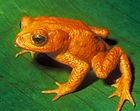Quasi-extinction refers to the state in which a species or population has declined to critically low numbers, making its recovery highly unlikely, even though a small number of individuals may still persist. This concept is often used in conservation biology to identify species at extreme risk of extinction and to guide management strategies aimed at preventing complete extinction. Quasi-extinction is typically characterized by an inability of the population to sustain itself due to genetic, demographic, or environmental factors.
Extinction threshold
The quasi-extinction threshold, or sometimes called the quasi-extinction risk is the population size below which a species is considered to be at extreme risk of quasi-extinction. This threshold varies by species and is influenced by several factors, including reproductive rates, habitat requirements, and genetic diversity. It is often used in population viability analyses (PVA) to model the likelihood of a species declining to levels where recovery becomes nearly impossible.
References
- Engen, S.; Saether, B. E. (2000-08-21). "Predicting the time to quasi-extinction for populations far below their carrying capacity". Journal of Theoretical Biology. 205 (4): 649–658. doi:10.1006/jtbi.2000.2094. ISSN 0022-5193. PMID 10931759.
- Block, G. L.; Allen, L. J. (March 2000). "Population extinction and quasi-stationary behavior in stochastic density-dependent structured models". Bulletin of Mathematical Biology. 62 (2): 199–228. doi:10.1006/bulm.1999.0147. ISSN 0092-8240. PMID 10824427.
- Engelson, Andrew (2021-12-16). "What does 'quasi-extinction' actually mean?". Columbia Insight. Retrieved 2024-12-16.
- Legendre, Stéphane; Schoener, Thomas; Clobert, Jean; Spiller, David (August 2008). "How Is Extinction Risk Related to Population‐Size Variability over Time? A Family of Models for Species with Repeated Extinction and Immigration". The American Naturalist. 172 (2): 282–298. doi:10.1086/589454. ISSN 0003-0147.
- Morris, W. F.; Doak, D. F. (22 June 2002). Quantitative conservation biology: Theory and practice of population viability analysis. Sunderland, Massachusetts, USA: Sinauer Associates. ISBN 9780878935468.
- Holmes, Elizabeth Eli; Sabo, John L.; Viscido, Steven Vincent; Fagan, William Fredric (December 2007). "A statistical approach to quasi-extinction forecasting". Ecology Letters. 10 (12): 1182–1198. doi:10.1111/j.1461-0248.2007.01105.x. ISSN 1461-0248. PMID 17803676.
- Ludwig, Donald (1996). "Uncertainty and the Assessment of Extinction Probabilities". Ecological Applications. 6 (4): 1067–1076. doi:10.2307/2269591. ISSN 1939-5582.
| Extinction | |||||
|---|---|---|---|---|---|
| Phenomena |  | ||||
| Models | |||||
| Causes | |||||
| Theories and concepts | |||||
| Extinction events |
| ||||
| Extinct species | |||||
| Organizations | |||||
| See also | |||||
| Zoos, aquariums, and aviaries | |
|---|---|
| Types of zoos | |
| Conservation | |
| Lists | |
| Related | |
| Deforestation and desertification | ||
|---|---|---|
| Deforestation |  | |
| Desertification | ||
| Mitigation |
| |
| Related articles | ||
| Death | |||||||||||||
|---|---|---|---|---|---|---|---|---|---|---|---|---|---|
| In medicine |
| ||||||||||||
| Lists | |||||||||||||
| Mortality | |||||||||||||
| After death |
| ||||||||||||
| Paranormal | |||||||||||||
| Legal | |||||||||||||
| Fields | |||||||||||||
| Other |
| ||||||||||||